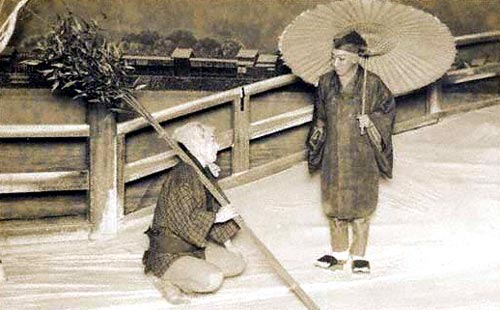| MATSUURA NO TAIKO |
| Play title | Matsuura no Taiko Shin Butai Iroha no Kakizome Seichű Gishi Genroku Kabuki Matsuura Jindaiko |
| Authors | Segawa Jok˘ III, Ky˘gend˘ Sak˘ II ("Shin Butai Iroha no Kakizome") Katsu Genz˘ III ("Seichű Gishi Genroku Kabuki") |
| History |
The first version of "Matsuura no Taiko" was staged in the 5th lunar month of 1856 at the Moritaza, as extended acts (3 acts to be precise) of the classic "Kanadehon Chűshingura". This program, which celebrated the reopening of the Moritaza was entitled "Shin Butai Iroha no Kakizome". The roles of Takarai Kikaku and Lord Matsukura were played by ďtani Tomoemon IV and Morita Kan'ya XI. Katsu Genz˘ III reworked these three acts and made an independent play, which was entitled "Seichű Gishi Genroku Kabuki" and was staged in March 1882 at the Kado no Shibai. As he was no more subjected to censorship, Katsu Genz˘ III was able to use the real names of the protagonists and, in this new version, Lord Matsukura became Lord Matsuura. This role was played by Nakamura Tokiz˘ I. This drama was restaged in January 1900, in ďsaka at the Asahiza, under the title "Matsuura Jindaiko" (it started to be called "Matsuura no Taiko" from that time), starring Nakamura Tokiz˘ I in the role of Matsuura Shizunobu. This role became one of his atariyaku and he transmitted it to his son Nakamura Kichiemon I, who decided to put "Matsuura no Taiko" in his collection of dramas Shűzan Jisshu. He taught the role to his younger brother Nakamura Kanzabur˘ XVII, who taught it to Nakamura Kichiemon I's adopted son Nakamura Kichiemon II. |
| Structure |
"Matsuura no Taiko" is made up of 2 acts (3 scenes). |
| Key words |
Ak˘ R˘shi Asano Naganori Chűshinguramono Gishi Gishi Ky˘gen Haiku Kira Yoshihisa ďtaka Tadao R˘nin Ry˘gokubashi Shijűshichishi Shűzan Jisshu Takarai Kikaku |
| Summary |
This play depicts one of the episodes connected with the famous vendetta of 47 r˘nin of Ak˘. On a snowy evening, in the mansion of Lord Matsuura, the haiku poet Takarai Kikaku relates to the lord, who is a sympathizer of the ill-fated Lord Asano, that on the day before he happened to meet ďtaka Gengo, his former haiku disciple and one of the retainers of Lord Asano, near Ry˘goku Bridge. Kikaku says he composed the first half of a haiku and Gengo responded by improvising the latter half, which said, "the much-awaited treasure ship comes tomorrow." Hearing this, Lord Matsuura instantly senses that the 47 r˘nin's vendetta is scheduled for that very night. At that moment, Yamaga-style drum beats signal the attack on Lord Kira, the target of the vendetta, who lives next doors. Source: Earphone Guide website |
 |
|
A pre-war postcard of "Matsuura no Taiko", with ďtaka Gengo on the left and Takarai Kikaku on the right (unknown casting) |
|
|
| Contact | Main | Top | Updates | Actors | Plays | Playwrights | Programs | Links | FAQ | Glossary | Chronology | Illustrations | Prints | Characters | Derivatives | Theaters | Coming soon | News |